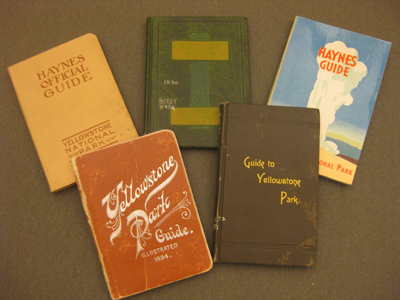
One of our favorite library collections is the Haynes Guidebook collection, put out by the famous Yellowstone photographers. Their guidebooks were printed almost every year from 1890-1966. The text for the first ten years was actually provided by the Haynes' accountant, A. B. Guptill with Frank J. Haynes providing the pictures. Frank then took over textual duties (with some help from the Superintendent) until he passed the Haynes shops to his son.
There were variations (e.g. the 1893 book is the 1892 version with a stamp on the front cover) of the guidebooks available during some of the non-printing years. The Yellowstone Research Library is lucky to have all of the printed years as well as all of the identified variants. We have second copies of almost all of the books and those copies can be viewed in the Reading Room. One of the coolest is from the year the Canyon hotel opened when they included a little copper plate in the books. That particular edition is kept in our Rare Book Room.
The title changed only three times over the course of the run from the original Practical Guide to Yellowstone National Park in 1890 to All About Yellowstone Park (1892, 1893) to Haynes Guide Handbook of Yellowstone Park. The covers changed more often, with some years having both soft covers and leather-bound covers, but the most well-known is probably the cover the company started using in the late teens, an erupting geyser against a blue sky with "Haynes Guide" printed in red capital letters across the top of the geyser
Though these were not the first guidebooks produced about Yellowstone (there were two books published in 1873), this set was the longest running. This means that our researchers can reap a goldmine of information including (but not limited to) road changes, rules and regulations, prices for hotels and coach rides, and opening/closing dates for the season. They can track these changes through time. These books are also great for people whose parents or grandparents (or even great-grandparents) came through the park to find out what the original experience might have been like.
Sources: Many thanks to Leslie Quinn for providing the librarians with much of the background information on the Haynes Guides.
